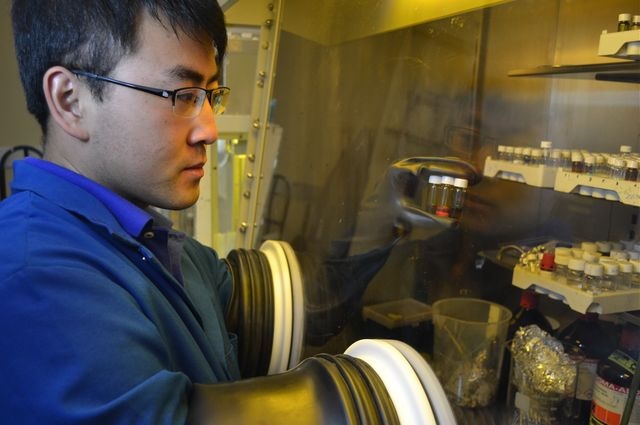 A UCLA graduate student researcher with two of the polymers used in developing more efficient solar cell technology, as well as a polymer blend. Image Credit: UCLA Engineering
A UCLA graduate student researcher with two of the polymers used in developing more efficient solar cell technology, as well as a polymer blend. Image Credit: UCLA Engineering
Researchers from the UCLA Henry Samueli School of Engineering and Applied Science have recently identified a key technique to enhance the performance of high-efficiency polymer cells, which has the capability to create lighter and more flexible solar devices in the future.
The UCLA researchers led by Yang Yang, the Carol and Lawrence E. Tannas Jr. Professor of Engineering have discovered the main principles required for promoting the development of high-efficiency polymer solar cells.
Currently, commercially manufactured solar panels rely on silicon cells to effectively produce energy from sunlight. However, the main drawback with silicon panels is that they are very heavy to be used as energy-producing coatings for cars and buildings or as portable and flexible power supplies in inaccessible regions. The solution to this problem can be found in polymer cells.
The research team has managed to combine different sets of polymers in order to allow gadgets to absorb light from a larger section of the solar spectrum. They also recognised criteria that could pave the way for higher solar cell efficiency and absorption of light as researchers continue to process and develop new polymers.
According to Yang, solar cells possessing varied molecular structures or different materials display diverse potential in terms of flexibility, efficiency and cost-effectiveness.
Perovskite cells, discovered a couple of years ago, are highly promising with regards to efficiency, however more research is required into these cells. In contrast, the polymer cells have been researched for several years and possess the benefit of being light in weight, as well as economical to manufacture.
“As polymer solar cells become more efficient,” said Yang, “they could have a profound impact on our ability to tap the power of the sun.”
In the last decade, researchers have created polymers containing varied molecular structures in order to develop materials capable of absorbing light from different portions of the solar spectrum. They also have combined two or more polymers on one gadget in order to accelerate absorption. However, the UCLA researchers noticed that the blending process had not provided the required improvement.
As a result, the UCLA researchers established that this issue too can be solved by cautiously choosing polymers possessing molecular structures that are well-suited with each other. They tried out various combinations of polymers and device architectures. They decided on the most ideal combinations capable of improving the efficiency of the solar cells and also determined which combinations were not well-suited with each other.
“By experimenting with the molecular organization and crystallite size of the polymers, and the architecture of the cell, we found a rule for selecting the proper pair of polymers to enhance efficiency,” Yang said. “These findings can help chemists design better pairs of polymers and reach even higher efficiency in the future.”
The research findings can be found in Nature Photonics.